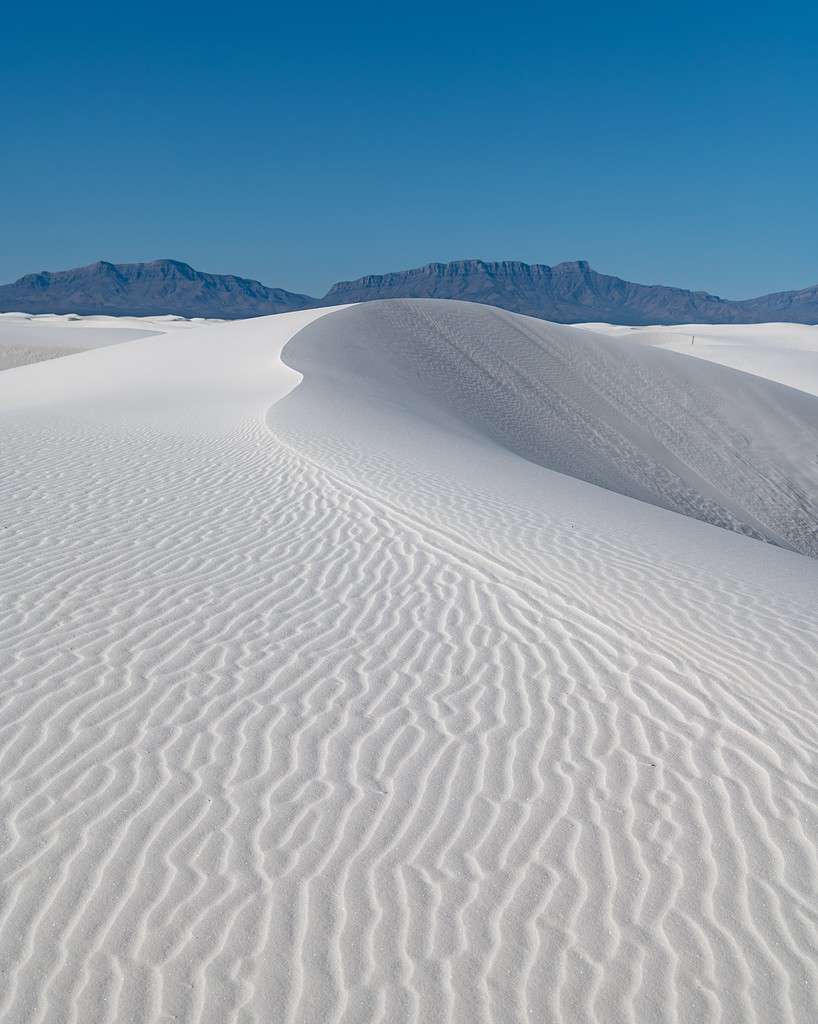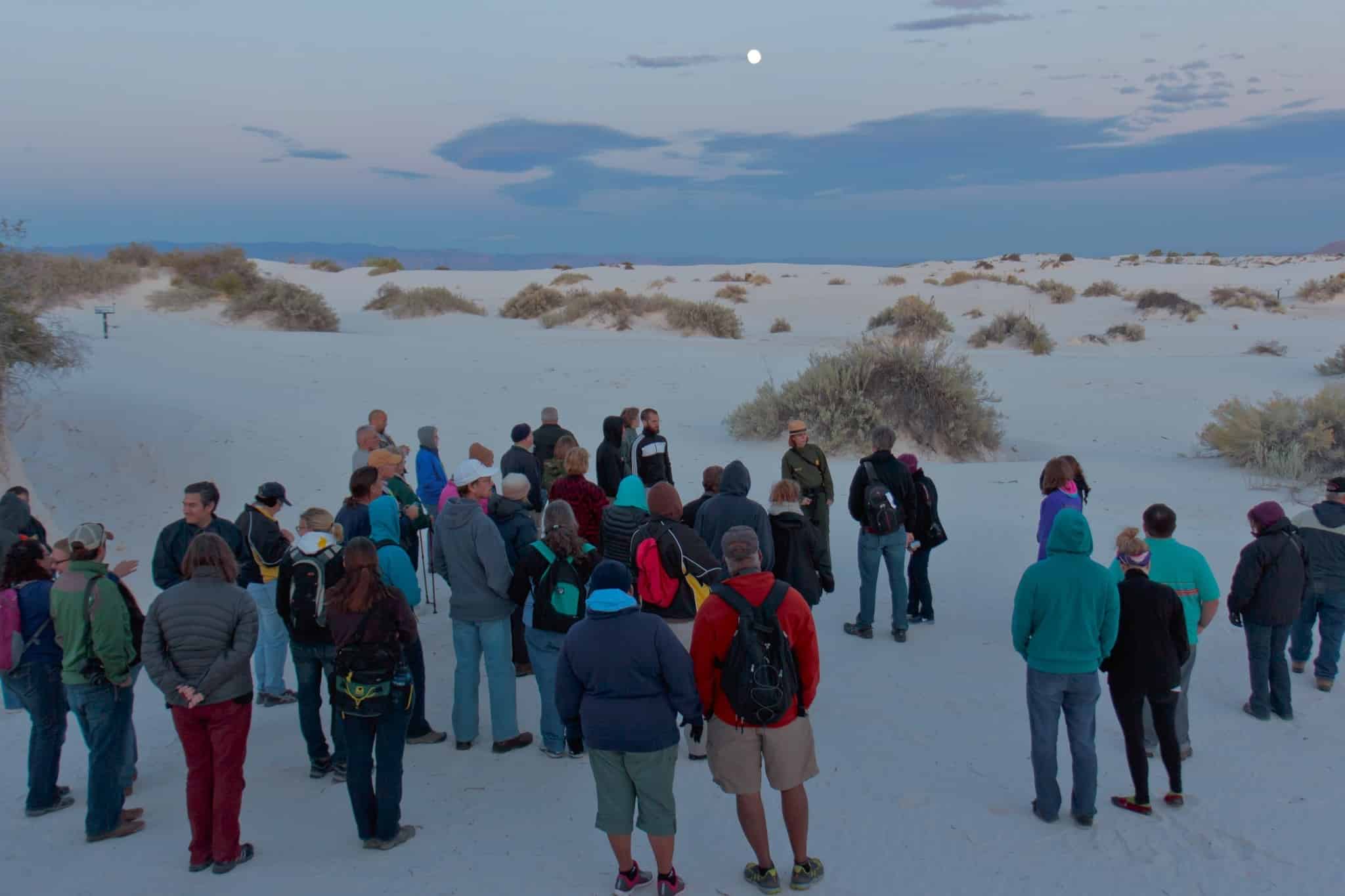White Sands National Park offers a unique experience for stargazers and nature aficionados alike. Set against the surreal backdrop of glistening gypsum dunes, the park’s night sky programs are an invitation to gaze upon the stars and planets that blaze across the New Mexican sky with an intensity and clarity seldom seen elsewhere. Visitors are led by rangers on moonlight hikes, providing not only a safe passage through the desert’s nighttime landscape but also insight into the celestial stories woven into the park’s rich history.

These night sky programs go beyond casual observation. They are designed to educate visitors about the importance of dark skies and the roles that stars and constellations have played in navigation and culture throughout humanity’s history. Whether it’s through planned stargazing events or impromptu looks through a telescope, the park creates an accessible window to the cosmos for people of all ages. The preservation of this dark sky sanctuary allows for an astronomical experience that also underscores the crucial conservation efforts implemented to keep White Sands a treasure for nocturnal wildlife and future generations of star seekers.
Key Takeaways
- The park’s night sky programs offer guided moonlight experiences and stargazing events.
- Educational efforts highlight the cultural and navigational significance of constellations.
- Conservation practices ensure the protection of the park’s pristine dark skies and nocturnal wildlife.
[ez-toc]
Discovering the Celestial Wonders
Embrace the splendor of the night sky at White Sands National Park, where the pristine dunes become a stage for celestial observation. This section navigates the essentials of stargazing, the night sky programs available, and photography tips for capturing the starry wonders.
Stargazing Basics at White Sands
To fully enjoy the stellar views at White Sands, visitors should familiarize themselves with stargazing essentials. It’s crucial to check the lunar calendar and aim for nights with a new moon for the darkest skies. The park’s open dunes provide an unobstructed view of constellations, planets, and meteor showers, best observed with binoculars or a telescope set up away from any artificial lights.
Night Sky Programs Overview
White Sands National Park offers an array of night sky programs tailored to inspire and educate visitors about astronomy. These programs include ranger-led full moon walks and night sky parties where telescopes are provided for public use. Guests not only learn about the cosmos but also gain knowledge on cultural and natural elements that define the park’s landscape under the night sky.
Tips for Night Sky Photography
For those looking to capture the park’s nighttime allure, a few key tips for night sky photography can make all the difference:
- Use a tripod for stability and a camera capable of long exposures.
- Set your camera to a high ISO and utilize a wide aperture.
- Experiment with shutter speed, starting from 20 seconds, to avoid star trails unless intentionally captured.
By following these guidelines, photographers can produce vibrant and clear images of the Milky Way and other celestial phenomena above the dunes.
Planning Your Visit

Visitors to White Sands National Park can enrich their experience by engaging in nighttime activities that showcase the unique landscape under the stars. From full moon walks to stargazing events, careful planning can ensure a memorable visit.
Best Times of Year for Stargazing
June to October: Full moon hikes are available, providing a unique way to see the dunes. These are generally offered once a month, and timing may vary based on the lunar calendar.
March to November: The park schedules guided moonlight hikes where rangers share stories and information about the park’s nocturnal environment.
Stargazing Conditions: The park’s remote location and low light pollution provide optimal stargazing conditions. Location-specific guides and maps can suggest the best times and locations within the park for stargazing.
Visitor Center Activities
Ranger Programs: Check the park’s official website or contact the visitor center upon arrival to find out about scheduled ranger-led programs, which may include talks or walks focused on the night sky.
Educational Material: The visitor center offers educational displays and resources that can deepen understanding of what makes White Sands a prime stargazing location.
Park Regulations and Safety
Stay Safe: Visitors must abide by all park regulations, such as staying on designated trails during night hikes to protect both the delicate ecosystem and themselves.
Prepare Adequately: It is crucial to bring appropriate gear for nighttime temperatures, which may drop significantly, and carry sufficient water and snacks. Check with the park for any additional safety recommendations.
Educational Opportunities
White Sands National Park offers a variety of educational opportunities for astronomy enthusiasts and those curious about the night sky. Through its programming, participants gain in-depth knowledge about celestial features and astronomical observation techniques.
Ranger-led Astronomy Programs
Ranger-led astronomy programs at White Sands National Park provide an engaging way to learn about the cosmos. These programs often take place in easily accessible areas of the park, ensuring that everyone has the opportunity to join. The knowledgeable rangers share insights on constellations, celestial events, and the science behind the stars. Detailed scheduling for these programs can be found at the visitor center or on the park’s official website.
Astronomy Workshops
For a more hands-on experience, the park occasionally offers astronomy workshops. Participants can deepen their understanding of the night sky, learning about astrophotography, navigating the celestial sphere, and recognizing astronomical phenomena. These workshops cater to various skill levels, from beginners to more experienced stargazers. Updates and registration details for upcoming workshops can be tracked through the park’s educational events page.
Telescope Viewing Sessions
During telescope viewing sessions, visitors have the chance to gaze at the stars through high-powered telescopes provided by the park. These sessions allow for a closer look at celestial objects and are often a highlight of the park’s night-time offerings. The sessions are facilitated by rangers or volunteers who can help identify planets, stars, and galaxies. For current schedules and potential cancellations, it is best to check with the visitor center.
Special Events
White Sands National Park’s night sky programs offer unique experiences, from observing celestial bodies during special park events to participating in night-time recreational activities under the stars.
Annual Astronomy Festival
The Annual Astronomy Festival is a highlight at White Sands National Park, featuring telescope viewings, engaging talks by astronomers, and photography workshops. Visitors have the opportunity to observe the galaxy in stunning detail due to the park’s remote location and dark skies.
Moonlight Bike Rides
Moonlight Bike Rides provide an exhilarating way to see White Sands’ landscape. These guided tours allow cyclists to ride through the park’s luminescent dunes under the full moon, adding a new dimension to the park’s striking scenery.
Meteor Shower Viewing Nights
During Meteor Shower Viewing Nights, the park stays open late, offering visitors a chance to witness spectacular meteor showers. With minimal light pollution, these events offer a clear view of events like the Perseids and Geminids showers, making for an unforgettable experience.
Conservation Efforts

White Sands National Park is dedicated to preserving and enhancing the natural night sky. These efforts are essential not only for the benefit of park visitors, who come to experience the stars in their full glory, but also to protect the nocturnal wildlife that depends on darkness for survival.
Dark Sky Preservation
White Sands National Park has implemented measures to preserve the dark sky. This includes restricting artificial light sources, ensuring that internal and external lighting within the park follow dark sky compliant fixtures. The park’s commitment contributes to safeguarding the view of starry skies, allowing the public to experience the night sky as it has been seen for generations. Efforts to maintain the dark sky are crucial for the park’s goal to remain a sanctuary for both sky-watchers and the ecosystem that thrives under the cover of darkness.
Light Pollution Reduction Initiatives
To combat light pollution, White Sands National Park has undertaken several initiatives. They have installed lighting fixtures that minimize glare and reduce sky glow. These fixtures are strategically angled to direct light where it is needed, preventing the spread of light to unintended areas. By reducing light pollution, the park not only enhances night sky viewing for visitors but also significantly lessens the ecological impact on wildlife that can be disoriented or harmed by artificial light. The park actively promotes awareness about the importance of dark skies through educational programs and by advocating for responsible lighting practices in nearby communities.
Frequently Asked Questions
White Sands National Park offers a unique stargazing experience due to its dark skies and stunning natural backdrop. These FAQs address key aspects of the park’s Night Sky Programs.
What are the best times of year for stargazing at White Sands National Park?
The best stargazing experiences at White Sands National Park occur during the new moon phase when the skies are darkest. Mid-fall to spring provides clearer skies due to favorable weather conditions.
What should visitors expect at White Sands National Park’s Night Sky Programs?
Visitors should expect informative programs that may include telescope viewings, constellation tours, and night sky photography sessions. The park’s remote location ensures low light pollution for optimal viewing.
How can one access White Sands National Park after sunset for night sky viewing?
For special night sky events, the park extends its hours and may require Stay Late Passes. Regular park hours do not permit after sunset stays, except for these special occasions.
Are there any guided tours available for night sky observations at White Sands National Park?
Yes, the park regularly offers ranger-led night sky programs. These include telescope viewings and educational talks on astronomy tailored to offer memorable stargazing experiences.
What kind of astronomical features can be observed during White Sands National Park’s Night Sky Programs?
Visitors can typically observe a variety of celestial bodies including stars, planets, the Milky Way, and during certain times, meteor showers and satellites.
What are the park hours and are there special considerations for night-time access?
White Sands National Park usually closes at sunset. However, park closure notices should be checked for special events allowing evening access, and visitors should be aware of occasional closures for missile testing.
Contact Information
White Sands National Park
19955 Highway 70 West
Alamogordo, NM 88310
Phone: (575) 479-6124
